Do you have a scented, thinly-leaved woody shrub in your garden that bears whorls of pink, purple, blue, or white flowers in summer? This description fits two plants in particular: hyssop and lavender. But how can I tell the difference, you ask? Good question, because they are almost identical! Let’s investigate the mystery of hyssop vs. lavender: what are the differences?
Key Similarities
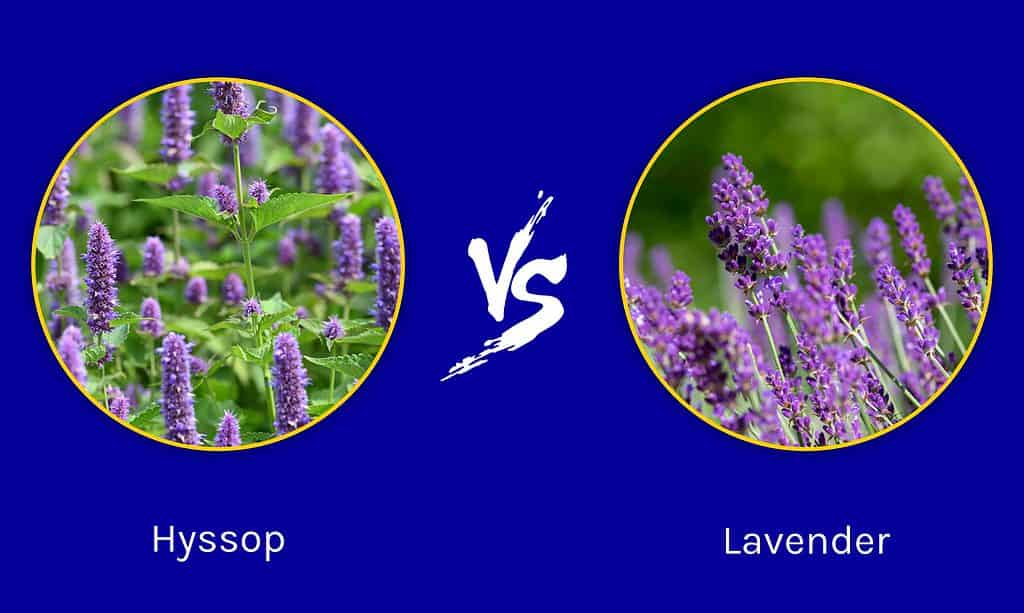
There are many more similarities between hyssop and lavender than there are differences!
The key similarities are their two-lipped whorled flower spikes in blue, purple, white, or pink, pinnate green foliage, and woody subshrub framework. They’re both scented, packed with essential oils, and adored by bees.
Key Differences
The main differences are hyssop has fatter and greener foliage than lavender’s silvery-gray leaves, and its flower stems are often wavy, whereas lavender stems are straight and vertical.
The final difference is hyssop’s scent has more aniseed tones than lavender.
| Name | Hyssop | Lavender |
|---|---|---|
| Foliage | Evergreen, pinnate, fine hairs, full of essential oils. Tends to be a richer green than lavender | Evergreen, pinnate, covered in fine hair, and contain essential oil. Silvery-gray in most species. |
| Height and spread | Around one foot by one foot | Around one foot by one foot. Some cultivars can reach three to four feet |
| Flowers | Tubular whorls, two-lipped, pink, purple, blue, or white on partially wavy stems. Looks slightly fluffier than lavender | Tubular whorls, two-lipped in pink, purple, blue, or white on straight stems |
| Growing Zone | 4-9 | 4-9 (5-9 for Spanish or French lavender) |
| Toxicity | Toxic if eaten in large quantities | Toxic if eaten in large quantities |
| Uses | Garden ornamental, pollinators friendly, medicinal, and culinary | Garden ornamental, pollinator-friendly, medicinal, and culinary |
| Native range | Mediterranean | Mediterranean |
What Is Lavender?
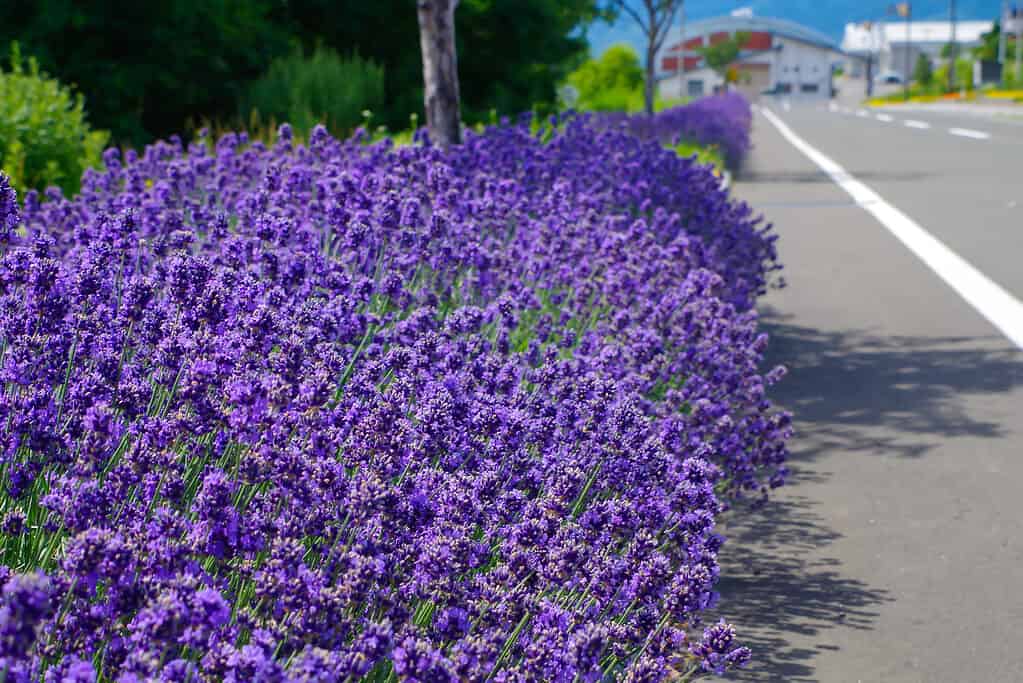
English lavender is the most common species of lavender.
©ajisai13/Shutterstock.com
Lavender is the common name for Lavendula which is a species of plant in the Lamiaceae mint family. There are 47 Lavendula species that originated in the Mediterranean and spread across most of the inhabited temperate world.
It’s a popular ornamental evergreen sub-shrub for gardens, but its essential oils are used extensively in commerce from traditional medicines to cosmetics.
From ancient times to the discovery of penicillin in 1928, lavender was used to treat injuries from battle wounds to childbirth. It’s a potent antifungal, antibacterial and antiseptic, and it’s still used to support anxiety and insomnia disorders today (although there are few good quality studies to back up the claims).
The most common species is Lavendula angustifolia also known as English lavender. This species is hardier than its Spanish or French lavender cousins and more likely to survive a cold winter.
What Is Hyssop?
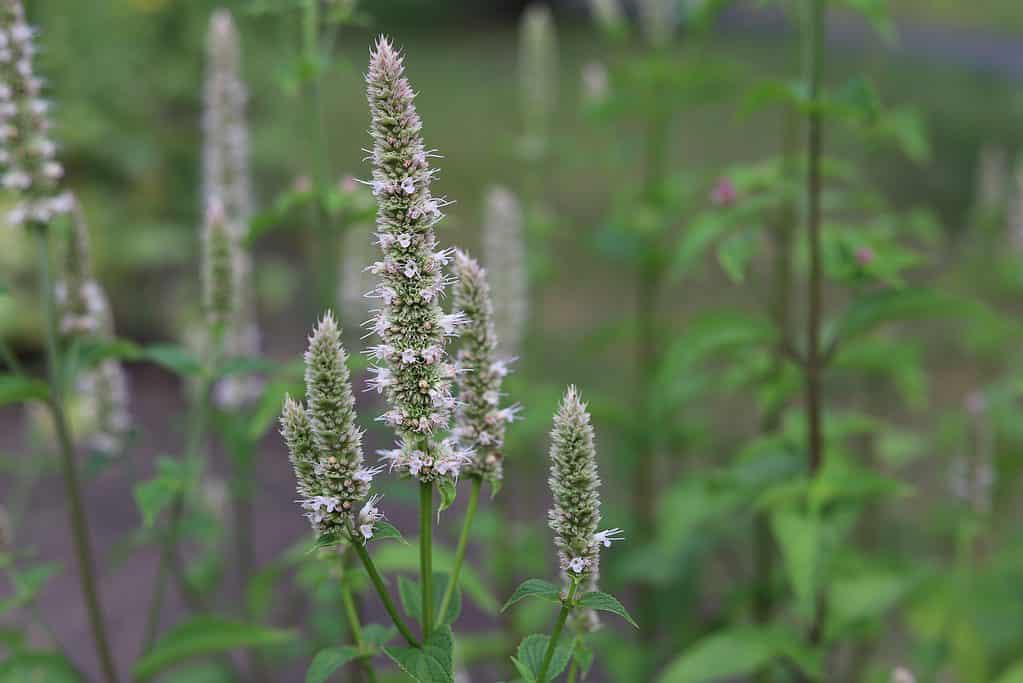
The yellow giant hyssop primarily grows in meadows, upland deciduous woods, and lowland woods.
©Kabar/Shutterstock.com
Hyssopus officinalis is very similar to Lavendula.
It’s also an evergreen sub-shrub in the Laminaceae mint family and native to the Mediterranean. There are 10-12 species and throughout history, the essential oils in hyssop’s foliage and flowers have been used to treat wounds and coughs.
But beware! There are several plants referred to as hyssop.
There is Hyssopus officinalis, the subject of this comparison, plus Agastache foeniculum, which is better known as the blue giant hyssop, and Agastache anethiodora commonly called anise hyssop.
The agastache hyssops are native to North America and grow much taller than Hyssopus officinalis.
Are Hyssop and Lavender Perennial?

Lavender (pictured) and hyssop are both perennial and evergreen plants.
©Mike Russell/Shutterstock.com
Yes, both hyssops and lavenders are perennial plants and they are both evergreens too.
This means they keep their foliage in the winter months, then grow more foliage and bloom in spring and summer time. In very cold climates they may lose all their leaves, but they will grow back in spring.
Although they are perennials, both hyssop and lavender are short-lived. Most are past their best after four to five years, so keen gardeners usually replace them.
Hyssop vs. Lavender: Foliage
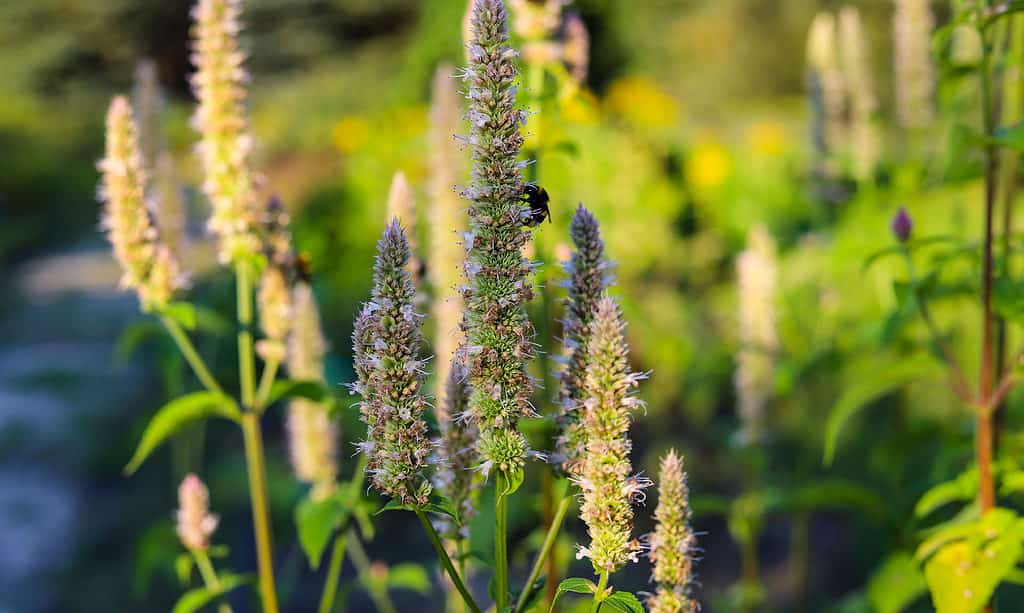
Covered in fine hairs is the foliage of both lavender and hyssop. Pictured is a yellow giant hyssop plant.
©Kabar/Shutterstock.com
Hyssops and lavenders are different species, but their foliage looks very similar.
Both plants have a shrubby wood framework with upright branches that reach about one foot in height and spread (unless you have a giant version such as the French lavender Grosse).
They both have foliage that’s pinnate, thin, covered in fine hairs, and packed full of antiseptic essential oils.
The main foliage difference is hyssop has greener, fatter individual leaves than silvery-gray lavender, and the essential oil smells more like aniseed than lavender.
They’re so similar, you’d be forgiven for mixing them up.
Hyssop vs. Lavender: Flowers
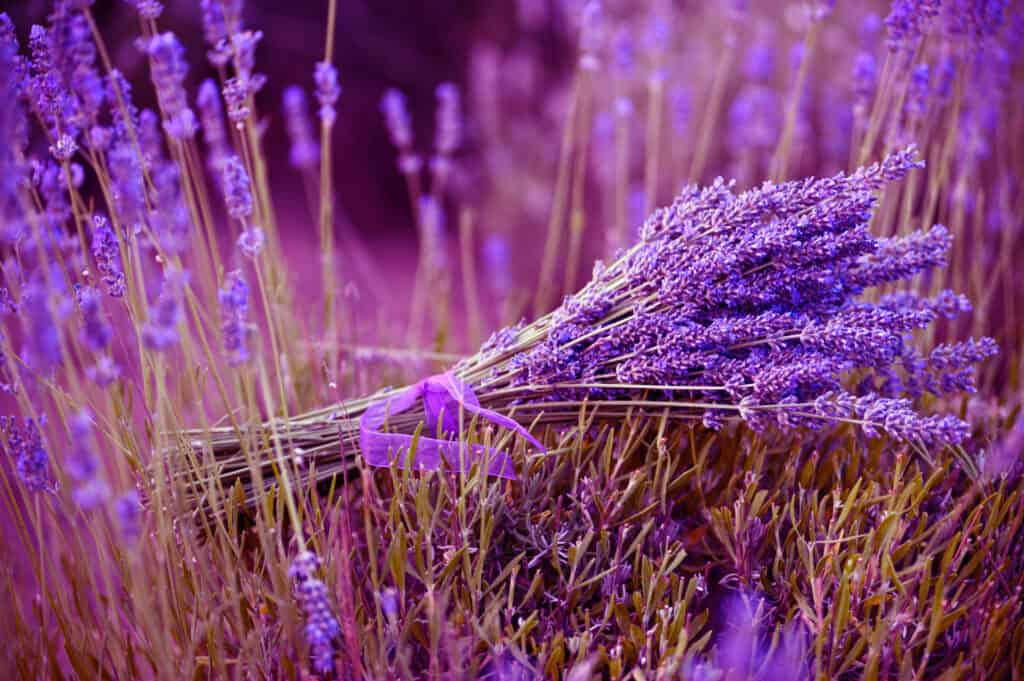
The flowers of hyssop and lavender are almost identical. Pictured here is lavender.
©freya-photographer/Shutterstock.com
Hyssop flowers are usually blue, pink, purple, or white. They bloom on the tips of erect but slightly wavy shoots. The blooms have two lips in whorled tubular shapes that bees and other beneficial pollinators can easily access.
Hyssop blooms in summer and will flower a second time if it’s deadheaded.
Lavender flowers are almost identical! The small difference is hyssop appears a little fluffier and less sleek than lavender. It is very difficult to tell unless you have them side by side.
Lavender and Hyssop Growing Zones
Both lavender and hyssop like dry, well-drained, sandy or chalky growing conditions, because they are Mediterranean natives. This means they grow best in hot zones that aren’t humid.
Humidity tends to breed fungus on both species and although they are relatively cold and hardy they don’t cope well with rain. The best growing zones for hyssop and lavender are zones 4 – 9, but they can be grown outside in lower zones with extra weather protection.
How To Grow Lavender and Hyssop
Sun-loving hyssops and lavenders are easy to grow given the right conditions. Here’s how to grow really healthy and fragrant shrubs.
Choose a sunny site
Both hyssops and lavenders will lean and get leggy if they have too much shade. Aim for six to eight hours of sunlight a day.
Provide well-drained soil
Mediterranean native plants prefer well-drained soil and tend to rot if their roots are consistently wet. Choose a sandy, rocky, chalky position, or add perlite to good-quality soil to take its richness down a notch. Overfed lavender and hyssop bolt and develop thin leggy branches.
Anti-fungal pruning
Cut back flower stems once the flowers are spent and certainly before any cold, wet weather approaches.
This makes sure hyssop and lavender plants get plenty of fresh air circulating around the crown to prevent fungus and premature, over-winter death.
Do Hyssop and Lavender Grow in Pots?
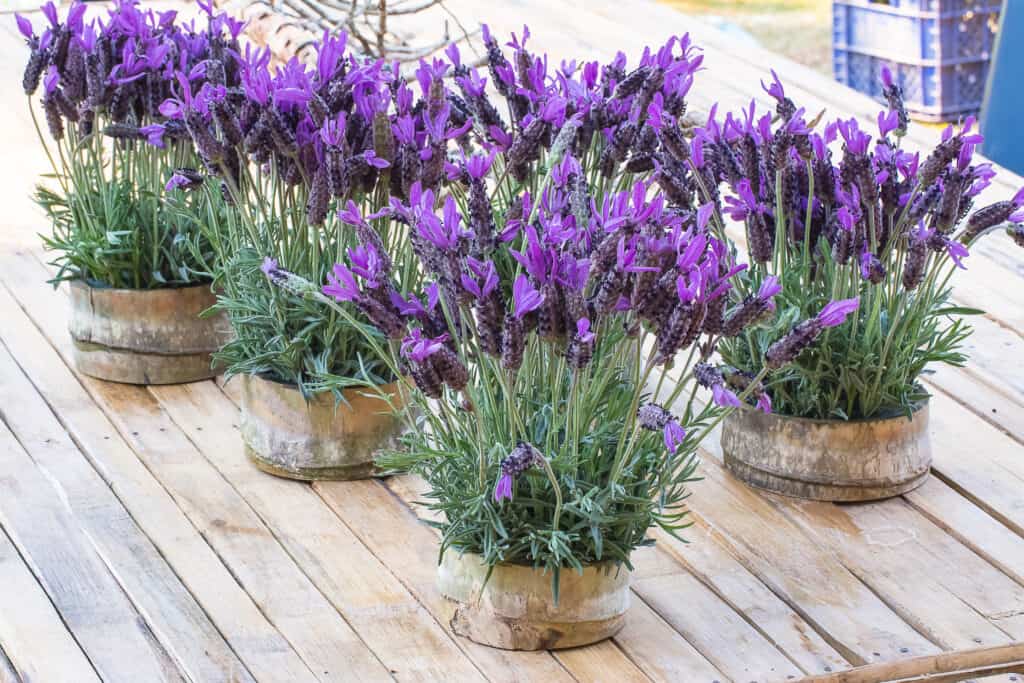
Lavender and hyssop both grow in pots. Pictured here are lavender plants in bamboo pots.
©Shan 16899/Shutterstock.com
Yes, because containers are free draining, hyssops and lavenders will happily grow in a pot. Just be sure to raise them slightly so any excess water can escape.
Are Hyssop and Lavender Toxic?
Both are used in traditional medicine, but it’s never a good idea to let kids or pets chew garden plants.
The essential oils in hyssops and lavenders can cause stomach upsets or skin irritation if they’re eaten in large quantities. That’s why the ASPCA lists lavender as toxic to dogs, cats, and horses.
How To Dry Lavender and Hyssop Flowers
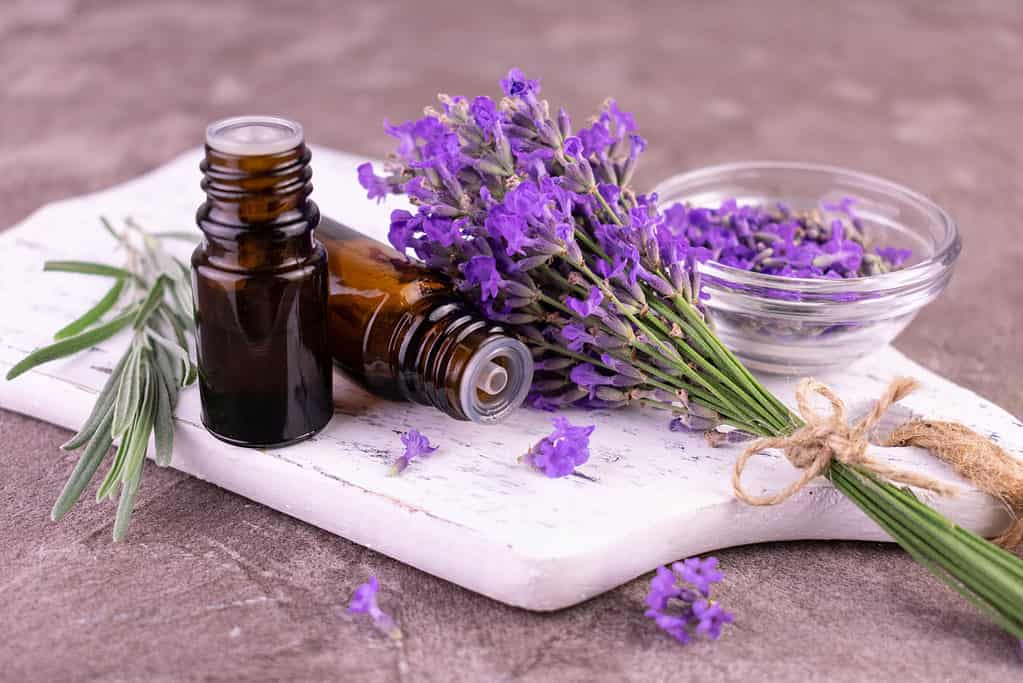
Some experts say the scent of lavender can help with insomnia.
©iStock.com/Olivka888
Dried flowers from the yard can easily be turned into sweetly scented room fragrances, and some experts suggest the scent of lavender can help with insomnia. It is worth a shot at drying out the flowers.
It’s best to cut flowers (and some foliage) in the morning when the plant is full of moisture and bursting with essential oils. Keep an eye out for early bees who might be having breakfast!
Once you’ve clipped enough flowers, tie a bunch by the stems and hang them upside down in a cool, dry place until they’ve dried. If you picked off flowers, just spread them across a kitchen towel and let them dry out that way.
If you’re a crafter, you could sew dried lavender and hyssop into small fabric envelopes, so they are neat and tidy beneath a pillow.
Conclusion: Hyssop vs. Lavender
The main difference between hyssop and lavender is the color and shape of their foliage. Hyssop has brighter green and fatter leaves than silvery-gray lavender. Hyssop also has slightly fluffier flowers and it smells a little more like aniseed.
They are so similar it’s difficult to tell them apart, but the good news is hyssops and lavenders enjoy the same growing conditions, so it doesn’t really matter if you can’t figure it out!
Up Next…
- French Lavender vs English Lavender: Is There a Difference?
- French Lavender vs Spanish Lavender: What Are The Differences?
- Is Lavender Perennial Or Annual?
The photo featured at the top of this post is ©
Sources
- Drugs.com, Available here: https://www.drugs.com/npp/lavender.html
- Gardeners World, Available here: https://www.gardenersworld.com/how-to/grow-plants/how-to-grow-hyssop/
- Royal Horticultural Society, Available here: https://www.rhs.org.uk/plants/9057/hyssopus-officinalis/details
- United States Department of Agriculture, Available here: https://planthardiness.ars.usda.gov/
Thank you for reading! Have some feedback for us? Contact the AZ Animals editorial team.






